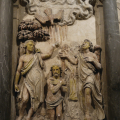NOTRE-DAME CATHEDRAL OF REIMS
Visit Notre-Dame de Reims Cathedral, home to a museum retracing Reims' Gallo-Roman past and regional archaeology.
A marvel of Gothic architecture, Notre-Dame de Reims Cathedral became the official coronation site for the kings of France in the 11th century with the coronation of Henry I. It is here that Clovis was baptized and that most of the Capetian kings were crowned, except for seven. Why Reims? The power of its archbishops is undeniable, but it is also for the presence of the Holy Bulb in the cathedral that it was chosen. The Holy Ampoule was a vial that contained the sacred oil used during the coronation of the kings of France, it would be the oil used during the baptism of Clovis. This Holy Ampoule was broken during the Revolution but some pieces were recovered and are now kept in a reliquary.
This attachment to royalty can be seen on the façade of the cathedral where a gallery of kings with 56 statues is enthroned. In the center of this gallery, one can see Clovis, his wife Clotilde and the bishop Rémi who baptized him. The structure of the cathedral is impressive, the western towers do not have spires but still reach 82 m! The nave of 38 m and its narrowness reinforces this idea of height, dear to the Gothic buildings. Symbol of royalty, the cathedral of Reims did not suffer its most violent attacks during the Revolution, during which it was used as a fodder store. Restored by Viollet-le-Duc in 1860, it became the target of German bombing in 1914. In total, it received more than 300 shells and a violent fire devastated it: the stained glass windows of the big rose exploded, the wooden frame collapsed and the statues broke! Restored in the 1920s and 1930s, the building now rests on an ingenious reinforced concrete framework designed by the architect Henri Deneux. A symbol of the ravages of war, the cathedral was also a witness to the Franco-German reconciliation that was made official in July 1962, when French President Charles de Gaulle and German Chancellor Konrad Adenauer came to visit. Heavily marked by the wars, the cathedral has not lost its beauty and has been patiently restored during the last century. As a martyred cathedral, it became the symbol of the city of Reims, 85% of which was razed to the ground during the First World War. Even today, its bell towers are home to only two bumblebees, named Marie and Charlotte. These bells, which weigh between 7 and 11 tons each, only ring on special occasions, so as not to damage the fragile structure of the building. As for the north tower, it has neither bell nor belfry but houses the old bells melted down from the 1914 fire. In spite of the various destructions, the building still has superb stained glass windows from the 13th century, in the upper part of the nave, the choir and the transept. In 1974, three modern creations by Marc Chagall(The Tree of Jesse, The Two Testaments and The Great Hours of Rheims) were added to these. Six stained glass windows by the German artist Imi Knoebel were added to the collection in 2011, adorning the chapels of the apse, alongside those of Chagall. In 2015, three other stained glass windows by the same German artist were installed in the chapel of Saint Joan of Arc. They are symbols of the Franco-German reconciliation. Inside the building, one will notice a nave on three levels, dear to the French Gothic of the 13th century. One can also admire the reverse side of the façade, made by Gaucher of Reims around 1260. This reverse side is hollowed out and houses 52 sculptures depicting biblical episodes. Outside, the western facade is characterized by its gallery of kings but also its floor of the great rose where a representation of the fight of David and Goliath is enthroned. The central portal is dedicated to the Virgin Mary, with statues symbolizing her coronation by Christ. The right portal is surmounted by a representation of a gable representing the Last Judgment and the left portal, the Passion of Christ. The Palais du Tau, which is located right next to the cathedral, is also worth seeing. The building, the classical palace as we see it now, was built in 1690 by Hardouin-Mansart, Louis XIV's first architect, and his student Robert de Cotte. It now houses the museum of the cathedral's work. It contains the original statuary of the cathedral as well as its treasure. Among the most remarkable pieces are the tapestries of "Fort Roy Clovis", woven in Arras at the end of the 15th century. They are located in the royal banquet room where the king and his retinue had lunch after his coronation. The talisman of Charlemagne and the chalice of Saint Remi are also visible. Notre-Dame Cathedral is a UNESCO World Heritage Site, as are the Tau Palace, the Basilica and the former Abbey of Saint Remi. The latter houses a museum that traces the Gallo-Roman past of Reims as well as its military history and regional archaeology. The museum exhibits in particular La Tenture de la vie de saint Remi, made up of ten large tapestries of the Renaissance as well as an impressive reconstitution of the facade of the house of the Musicians of the XIIIth century, decorated with five statues of minstrels. This ensemble is a must-see in Reims.
Did you know? This review was written by our professional authors.
Members' reviews on NOTRE-DAME CATHEDRAL OF REIMS
The ratings and reviews below reflect the subjective opinions of members and not the opinion of The Little Witty.










